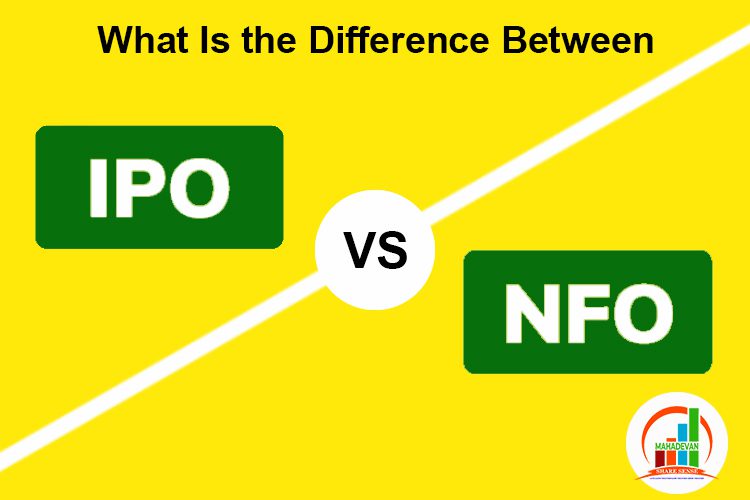

It is a known fact that companies require funds to expand their business. To fulfill this need, they go to public investors to gather these funds. A company can do this in one of the following ways: with the help of an IPO or NFO.
In general terms, for an IPO, the company offers its shares to the general public or investors. In an NFO, the investors are offered fund units. So, what is the difference between IPO and NFO? Let us understand in detail.
What Is an IPO?
IPO or Initial Public Offering is a process in which a company’s shares are sold to retail investors and institutional investors. The company may be a start-up, a new company, or an old one that decides to be listed.
An IPO is underwritten by an investment bank(s) and they also do the arrangement of listing the shares in the stock exchange(s). The company offering the stocks is called ‘Issuer. With this process, a private company is converted into a public company and is known as floating or going public.
What Are the Benefits Offered by IPO?
Some of the benefits offered by IPO are:
- To raise or gather new equity capital for the company.
- To monetize the investments of private shareholders like promoters, private equity investors, and company founders.
- To ensure better trading of current holdings or future capital raising by going public.
With an IPO, the shares of a company can be traded freely in the open market. These shares can be sold again by the investors via secondary market trading.
The stock exchanges stipulate a minimum free float in:
- Absolute Terms – The total value determined by the share price multiplied by the number of shares sold to the public, and
- As a proportion of the total share capital – The number of shares sold to the public divided by the total shares outstanding.
All the details of the proposed offering are shared with the potential investors via prospectus which is a detailed document. Even though an IPO comes with a lot of benefits, it is costly due to legal and banking fees, and the company needs to disclose even sensitive information to the investors. A lot of IPOs roll out each year in India making it a leading IPO market in the world.
Things to keep in mind before investing in an IPO
- Ensure that you know as much as possible about the company that is going public.
- It is not easy to get all the information about the company that is rolling out an IPO. Private companies are generally not tracked by analysts like public companies. Therefore, it is not possible to find out the loopholes in their corporate structure. Even though some companies claim that they have disclosed the smallest of the details of their business, the prospectus is still written by them and not by an unbiased third party.
- As an investor, you should pick an IPO that has a strong investment firm as an underwriter.
- Be skeptical if your broker is forcing you to buy an IPO.
- Read the prospectus of the company in detail.
To understand the difference between IPO and NFO, we should also have a deeper understanding of NFO. Read on to find out!
What is NFO?
An NFO or New Fund Offer is just like an IPO but with an exception. In the case of NFO, it is an AMC or Asset Management Company that launches a new scheme to raise capital. An AMC uses the money collected for buying securities like bonds or equities. They usually launch new MF (mutual fund) schemes during an NFO.
During this period, the investors buy units of the mutual fund scheme to subscribe to the NFO at an offer price. The price is usually fixed at Rs. 10. And after the tenure expires, the investors will have to buy the funds’ units at the price prevailing at that time. Generally, the subscribers of NFO gain profits after listing. Once the NFO period is over, the investors can avail these funds at the existing NAV or Net Asset Value of the fund.
Key Points To Remember About NFO or New Fund Offer
- They offer distinct themes or ideas.
- New Fund Offers are a good way to diversify your investment portfolio.
- NFO is generally launched as a limited period offer and can turn out to be a good investment.
- If you are looking for liquidity, you can invest in NFOs as you will have the option to sell or buy them anytime.
Differences between IPO and NFO
There are many differences between IPO and NFO. Some of them are tabulated below:-
| Parameters | IPO | NFO |
| Definition | An unlisted company announces an IPO when it decides to raise funds via the sale of its securities or shares for the 1st time to the public. | A New Fund Offer or NFO is the 1st time subscription offer for a new scheme launched by the AMCs or Asset Management Companies. It is launched to raise capital from the public to purchase securities like government bonds, shares, etc. |
| In Simple Terms | IPO is for new stock. | NFO is for a new mutual fund. |
| Valuation | For an IPO, the valuation of a company is essential. It is measured by the P/E (price-to-earnings) and P/BV (price-to-book) ratios. It is also important in finding the listing price. | In the case of NFOs, the valuations are not needed as the collected funds are split into units and are invested in the market. |
| Listing | IPO lists in the stock market below or above the price band that is set initially. This gives the investors a chance to earn profits if the price of the share rises on the day of its listing. | The AMCs launch once the raised funds have been invested in the market. The initial NAV of a fund is Rs. 10 or less due to marketing and administrative costs. |
| Pricing | IPO is priced based on the fundamentals of the issuing company and its valuation. | NFO is generally launched at a face value of Rs. 10. This doesn’t matter as the NAV is fixed based on the existing market conditions at the time of the launch. |
| Funds Usage | The company raises the funds to expand its business or to reduce the stake of the promoter in the company. | Asset Management Company uses this money to purchase securities like bonds and equities. |
Summing Up
IPO and NFO are similar as both are aimed at raising capital for further operations. If invested wisely, both options can deliver great returns. But make sure to carry out detailed research before investing your hard-earned money. Once you know what is the difference between IPO and NFO and all the risks associated with both options, you can make a wise investment decision.
If your risk appetite is medium to high and you want higher returns, you should go for an IPO. But if you have a medium to low-risk appetite, then it’s better to opt for NFO. In both cases, you must invest with patience.
Happy Investing!














